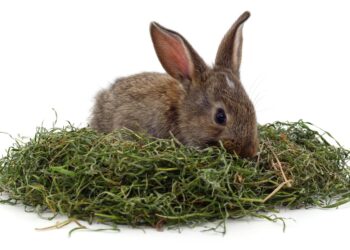Rabbits are social animals that like to spend time with others of their own kind. Especially when you keep a rabbit outside, it is advisable to keep two rabbits at a time. An animal that lives indoors also likes to have the company of another rabbit. But pairing rabbits is easier said than done. In the wild, there is a hierarchy between rabbits. If you just place two rabbits together, they will rank among each other and fight to see who is boss. That is why you have to proceed step by step and take some things into account. How do you pair rabbits and what do you need to know if you want to successfully pair rabbits?
Pairing rabbit: three myths
Every rabbit must be paired
It is a myth that rabbits should always be kept in pairs. Admittedly, keeping rabbits in pairs is definitely preferable. A rabbit is not made to live alone in an outdoor hutch, then feels lonely and bored.
But a rabbit that lives indoors, can get out of the cage at least twice a day for a few hours and has a lot of contact with its owners every day, can also feel fine on its own.
When you keep one rabbit, it is essential that the animal gets enough attention every day and not spend whole days alone in a cage. People who go out to work during the day should therefore keep two rabbits.
You can link a rabbit to a guinea pig
What is absolutely impossible is to house a rabbit together with another species such as a guinea pig or hamster. While rabbits and guinea pigs often get along well, they are very different animals with completely different nutritional needs and habits.
The guinea pig’s food is not suitable for rabbits and vice versa. In addition, a guinea pig can never replace a congener for a rabbit.
Pairing rabbit is easy
Pairing rabbits can go two ways. It can go very smoothly and you can determine that a male and female immediately like each other. You notice this, for example, when they start washing each other. With other rabbits, mating is quite a task.
Linking is often presented as something very simple, but that is definitely not the case. In fact, some rabbits may not be mated at all no matter what you try.
There is also no one simple way to pair rabbits that are guaranteed to work with all animals. Fortunately, there are a lot of useful tips and tricks that increase the chance of a successful connection.
What you need to know in advance
The chances of pairing two rabbits properly, according to experienced people, are greatest when the two rabbits are about the same size, breed, or age.
However, this does not mean that you cannot mate a young and an older rabbit, or that a small and large breed cannot get along. It might be a little more difficult.
Also, according to many, it is easiest to pair a male to a female, which does not mean that two males or two females cannot be paired at all.
Reading suggestions; Potty Training A Rabbit In 5 Efficient Steps
You should also know that very young rabbits that have not yet reached adulthood are almost impossible to mate. It is often better to postpone mating when both animals are only a few months old.
When a rabbit matures differs from breed to breed. Young rabbits mature after three to four months. In larger breeds, this is often only after seven to nine months.
Then you have to proceed step by step. Skipping or omitting one of the following four steps can mean the difference between a successful or a failed pairing.
- Step one: spay or neuter your rabbits
- Step two: exercise patience for another month
- Step three: let the rabbits get used to each other slowly
- Step four: the first encounters
Step one: spay or neuter your rabbits
For the coupling of a male and female, it may be clear that surgery is necessary for advancement to prevent pregnancy. However, many people think that it is not necessary to have same-sex rabbits spayed or neutered first.
Nothing could be further from the truth: with one rare exception, it is almost impossible to mate two males or two females if both have not been operated on first. Two males will fight sooner or later due to hormonal and territorial behavior. Also, two females can fight and show aggressive behavior when not spayed.
Your rabbit can have surgery from the age of six months. In addition to a better coupling, it has to spay or neuter your rabbit has many other benefits, especially avoiding cancers later in life in females.
There is no need to be afraid of surgery and anesthesia when you call on a rabbit expert. Although there are no zero risks with anesthesia, the chance that a knowledgeable vet will lose a young and healthy rabbit under anesthesia is extremely small.
As long as both rabbits have not been operated on, you must separate the rabbits to avoid a possible fight. After all, remember that rabbits have a very good memory. When they have fought with a congener they remember it for a long time. This can make it much more difficult to connect them afterward.
Step two: exercise patience for another month
After the surgery of both rabbits, it is recommended to wait at least another month before pairing the rabbits. In this way, wounds from the operation can first heal completely.
In addition, males remain fertile for at least three weeks to one month after surgery. So they can still conceive with a female after the operation!
Step three: let the rabbits get used to each other slowly
Before pairing the rabbits, it is advisable to put their cages side by side for a few weeks. This allows them to get used to each other’s smell, sound, and presence without the possibility of fighting.
Leave a small space between the two cages. This way they can’t claw at each other with their front legs.
Reading suggestions; 500+ Bunny Names For Your Pet Rabbit
Step four: tips for the first encounters
Neutral terrain
Then you can let the rabbits come into contact with each other for the first time. This happens the first time on neutral ground, such as the bathroom or a room that neither rabbit has visited before. Ten minutes is enough the first time.
Repeat this process regularly in the following weeks and allow the animals to spend some time together in this neutral space. You can gradually increase the duration with each new encounter.
The neutral space should not be too large. A common mistake is to choose a large room as a neutral space. It also sounds logical: they have more space to ‘do their thing’ in a large room. But too large an area with a strange rabbit often leads to “hunting” where one rabbit chases the other. You should avoid hunting because it does not promote coupling.
Then return them each to their own cage in the regular room but still keep the cages close together so they can continue to see each other. It may also help to alternate each rabbit between one cage and the other each week.
Pairing rabbits on the non-neutral territory is not impossible, but it is much more difficult and therefore not recommended.
Boxes
Another tip to promote the pairing of the rabbits is to give each rabbit its own toilet box in the neutral room. Also, place a cardboard box in the center of the room. This allows the rabbits to get out of each other’s sight for a while if they want to. Let them quietly explore the neutral room while you’re there, but don’t interfere.
It is also very important that you yourself remain in the background. Sitting with the two rabbits yourself does not help and can only disrupt the process. You must keep an eye on the rabbits from a distance, but above all let the animals ‘be together.
When to intervene
If the rabbits start fighting, separate them immediately. You have to break off a fight as soon as possible because rabbits remember this for a long time. This can make the connection more difficult afterward. You mustn’t intervene yourself.
You break off the fight by startling the rabbits. You can do this by stamping your feet loudly on the floor and firmly saying “No!” to say. Other people use a pan with a metal spoon that they knock on or the noise of a vacuum cleaner suddenly turning them on.
Again, you must keep your distance when you make noise. When the rabbits are startled, they will not look at you but seek support from each other. This promotes the pairing process.
At the same time, however, it is also important that you do not intervene too quickly. When one of the rabbits briefly mounts the other it only means an expression of dominance: you do not have to separate them. Also growling, knocking with the hind legs, orbiting is often just part of the normal process.
As long as the rabbits aren’t constantly biting each other hard, chasing each other excessively, or engaging in a real fight, resist the urge to intervene at the slightest sign of aggression.
On the right track?
After a while, you can see that the animals are licking each other’s fur. Sometimes this happens at the first meeting, other times only after several weeks. This is a good sign and indicates that they are starting to get along. Even when they sit together indifferently and undisturbed or eat together, you are on the right track.
Patience is a beautiful virtue
Successfully pairing rabbits takes more than one attempt. It may take a month or more for the two animals to get along. Also, don’t leave the rabbits together just because the first encounters went well.
You can only safely keep them together in the same cage or let them play together after they have gotten along well for at least two weeks. With a lot of patience, your animals can become friends for life!









